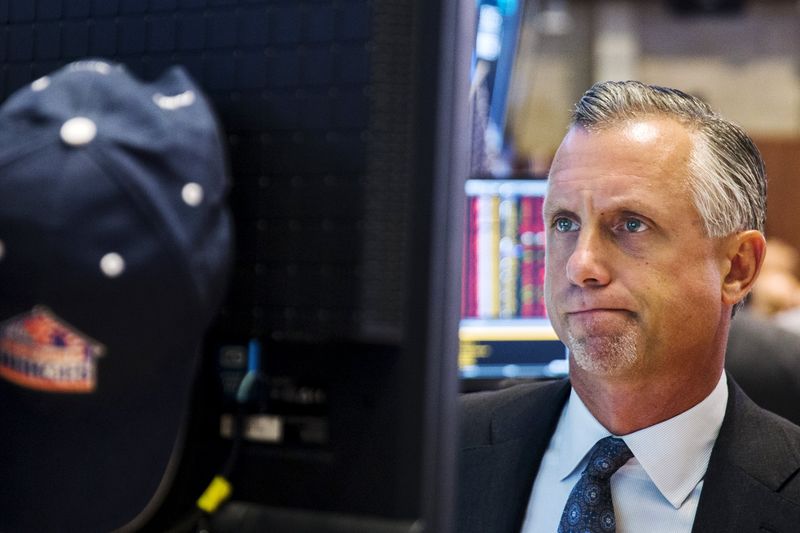AlphaTON stock soars 200% after pioneering digital asset oncology initiative
(For a live blog on the U.S. stock market, click LIVE/ or
type LIVE/ in a news window)
* Indexes drop: Dow 3.56%, S&P 3.35%, Nasdaq 3.71%
* Energy, technology stocks lead the slide
* Wall Street's fear gauge surges to over 1-yr high
* Health insurers fall after Sanders' Nevada victory
(Recasts first paragraph and paragraph 15, updates volume in
last paragraph)
By Sinéad Carew
New York, Feb 24 (Reuters) - The S&P 500 .SPX and the Dow
Jones Industrial Average .DJI on Monday suffered their biggest
one-day percentage losses in two years after a surge in
coronavirus cases outside China fanned worries about the global
economic impact of a potential pandemic.
Investors sold riskier assets and rushed to traditionally
safer bets such as gold and U.S. Treasuries after countries
including Iran, Italy and South Korea reported a rise in virus
cases over the weekend even as China eased curbs with no new
cases reported in Beijing and other cities.
The benchmark S&P 500, which represents over 44% of the
market capitalization of all global equities, lost $927 billion
of its value on Monday alone and $1.33 trillion since its
closing high on Wednesday last week, according to S&P Dow Jones
Indices senior analyst Howard Silverblatt.
The S&P and the blue-chip Dow turned negative for the year
to date and the Dow dropped more than 1,000 points on the day
for only the third time in its history.
The technology-heavy Nasdaq .IXIC fell 3.71%, the biggest
daily percentage drop of the three major averages.
"We're not likely to make any progress higher until we have
evidence the spread of the coronavirus is decelerating," said
Mark Luschini, chief investment strategist at Janney Montgomery
Scott in Philadelphia.
The Dow Jones Industrial Average .DJI fell 1,031.61
points, or 3.56%, to 27,960.8, the S&P 500 .SPX lost 111.86
points, or 3.35%, to 3,225.89 and the Nasdaq Composite .IXIC
dropped 355.31 points, or 3.71%, to 9,221.28.
All of the 11 major S&P sectors closed in the red, led by
the energy sector's 4.7% decline and followed by a 4.2% drop in
technology stocks .SPLRCT .
Apple Inc AAPL.O slid 4.8% as data showed sales of
smartphones in China tumbled by more than a third in January.
China-exposed chipmakers fell, with the Philadelphia SE
Semiconductor index .SOX dropping 4.8%, while concerns about
growing travel curbs dragged the NYSE Arca Airline Index .XAL
down 6%.
Of the S&P's sectors, the defensive utilities .SPLRCU ,
real estate .SPLRCR and consumer staples .SPLRCS indexes
fell the least on the day.
Treasury yields fell to their lowest levels since 2016 as
investors sought safety in government bonds, while the yield
curve inversion between the 3-month and 10-year U.S. Treasuries
deepened in what is often viewed as a recession predictor.
Adding to worries, Goldman Sachs slashed its U.S. growth
forecast on Sunday and predicted a more severe impact from the
epidemic. US/
The CBOE Volatility Index .VIX , a gauge of investor
anxiety, registered its biggest one-day jump since February 2018
and ended the day at 25.03, its highest closing level since
January 2019.
"There was this underlying concern that was out there, and
obviously over the weekend, it just escalated," said Stacey
Gilbert, portfolio manager for derivatives at Glenmede
Investment Management in Philadelphia.
After Monday's nosedive, the S&P closed almost 5% below its
record closing high, achieved last week, while the Nasdaq ended
6% off its peak close and the Dow ended the day 5.4% below its
record close.
The S&P 500 fell below its 50-day moving average and the Dow
slipped below its 100-day moving average, all closely watched
technical indicators.
Health insurers such as UnitedHealth Group Inc UNH.N and
Cigna Corp CI.N dropped almost 8% after Senator Bernie
Sanders, who backs the elimination of private health insurance,
strengthened his position for the Democratic presidential
nomination with a victory in the Nevada caucuses. Janney Montgomery Scott's Luschini said that while the
coronavirus was "by far and away the primary influence" for the
market's decline on Monday, investors, he said, were "also
beginning to handicap the odds of Sanders being the Democratic
nominee."
In a rare bright spot, Gilead Sciences Inc GILD.O , whose
antiviral remdesivir has shown promise in monkeys infected by a
related coronavirus, rose 4.6%.
Declining issues outnumbered advancing ones on the NYSE by a
6.74-to-1 ratio; on Nasdaq, a 6.02-to-1 ratio favored decliners.
The S&P 500 posted seven new 52-week highs and 23 new lows;
the Nasdaq Composite recorded 21 new highs and 154 new lows.
On U.S. exchanges, 10.59 billion shares changed hands,
compared with the 7.79 billion average for the last 20 sessions.
Coronavirus timeline Image https://tmsnrt.rs/2T9wklM
S&P 500 industry sectors https://tmsnrt.rs/2VmmUpB
^^^^^^^^^^^^^^^^^^^^^^^^^^^^^^^^^^^^^^^^^^^^^^^^^^^^^^^^^^^>
